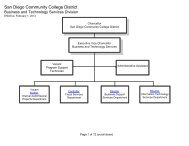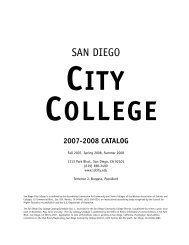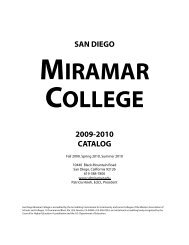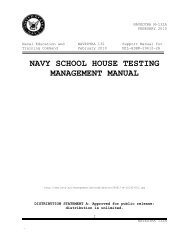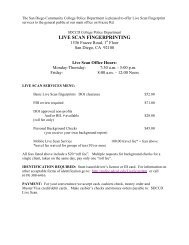NAVY SCHOOL MANAGEMENT MANUAL
NAVY SCHOOL MANAGEMENT MANUAL - AIM
NAVY SCHOOL MANAGEMENT MANUAL - AIM
- No tags were found...
You also want an ePaper? Increase the reach of your titles
YUMPU automatically turns print PDFs into web optimized ePapers that Google loves.
Class schedules shall be submitted annually when<br />
specifically requested by NETC message. As a result<br />
of annual feasibility studies, updated student input<br />
plans are not entered into CeTARS Schoolhouse until<br />
just prior to calling for the schedules. Therefore,<br />
do not submit schedules prior to the call.<br />
<br />
<br />
<br />
When resource limitations such as staff, personnel,<br />
equipment, or facilities impact the ability to conduct<br />
classes as scheduled, an Impaired Training and Education<br />
Report (ITER) shall be submitted immediately. Refer to<br />
NETCINST 1540.1 (series). Recommendations to cancel a<br />
class convening due to resource limitations will be<br />
resolved by NETC through the ITER reporting process.<br />
Delaying a class convene for reasons other than resource<br />
limitations is not the same as canceling a class. When a<br />
considering delaying a class convene, ensure the decision<br />
is based on sound cost benefit analysis. An example,<br />
delaying 15 students for three days while awaiting the<br />
arrival of two students in a course that convenes weekly is<br />
not cost effective. However, delaying the same 15 students<br />
three days in a course that convenes quarterly is<br />
justified. If the delay is expected to exceed 15 days,<br />
submit an ITER.<br />
Classes that do not convene due to a total lack of students<br />
or insufficient student numbers to meet a safety<br />
requirement are exempt from submitting an ITER.<br />
SECTION 11 - STUDENT QUOTA <strong>MANAGEMENT</strong><br />
11.1. The overall objective of the Navy Training quota<br />
management process is to train the right quantity of personnel<br />
at the right time. The quota management is directly related to<br />
training requirements and class schedules. Training<br />
requirements are determined, class schedules are submitted to<br />
CeTARS schoolhouse, and quotas are spread. The Planning<br />
Management Office performs centralized quota control for "A" and<br />
"C" and NEC producing pipelines. OPNAVINST 1500.47 (series)<br />
describes the Navy Training Quota Management Process. Quotas<br />
for "F,” “T’ and “D” schools are normally controlled by the<br />
TSC/department, however; in some instances, OPNAV (N132)<br />
controls quotas in these type courses as well.<br />
<br />
In the event OPNAV is unable to fill quotas in "A" and "C"<br />
schools due to non-availability of personnel or lack of<br />
TAD/PCS funds, seats may be filled locally. If quotas for<br />
"A" and "C” schools are not filled 30 days prior to class<br />
3-35<br />
NAVEDTRA 135C



